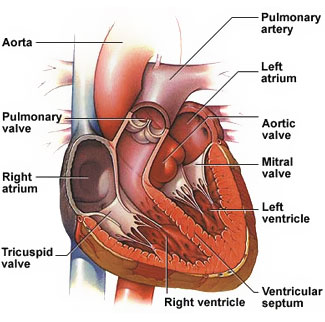Heart
Importance of our heart

The heart is one of the most important organs in the entire human body. It is composed of muscles which pumps blood throughout the body, beating approximately 72 times per minute of our lives. The heart pumps the blood, which carries all the vital materials which help our body to function and removes the waste products that we do not need. For example, the brain requires oxygen and glucose, which, if not received continuously, will cause it to loose consciousness. Muscles need oxygen, glucose and amino acids, as well as the proper ratio of sodium, calcium and potassium salts in order to contract normally. The glands need sufficient supplies of raw materials from which to manufacture the specific secretions. If the heart ever ceases to pump blood the body begins to shut down and after a very short period of time will die.
How does it work?

Like any other muscle in the human body, it contracts and expands. Each time the heart contracts it does so with all its force. The pumping of the heart is called the Cardiac Cycle, which occurs about 72 times per minute. This means that each cycle lasts about eight-tenths of a second. During this cycle the entire heart actually rests for about four-tenths of a second.
Our heart has 4 chambers. The upper chambers are called the left and right atria, and the lower chambers are called the left and right ventricles. A wall of muscle called the septum separates the left and right atria and the left and right ventricles. The left ventricle is the largest and strongest chamber in our heart. The left ventricle's chamber walls are only about a half-inch thick, but they have enough force to push blood through the aortic valve and into our body.
Four types of valves regulate blood flow through our heart:
- The tricuspid valve regulates blood flow between the right atrium and right ventricle.
- The pulmonary valve controls blood flow from the right ventricle into the pulmonary arteries, which carry blood to our lungs to pick up oxygen.
- The mitral valve lets oxygen-rich blood from our lungs pass from the left atrium into the left ventricle.
- The aortic valve opens the way for oxygen-rich blood to pass from the left ventricle into the aorta, our body's largest artery, where it is delivered to the rest of our body.
The Heart works as a pump moving blood around in our bodies to nourish every cell. Used blood, that is blood that has already been to the cells and has given up its nutrients to them, is drawn from the body by the right half of the heart, and then sent to the lungs to be reoxygenated. Blood that has been reoxygenated by the lungs is drawn into the left side of the heart and then pumped into the blood stream.
It is the atria that draw the blood from the lungs and body, and the ventricles that pump it to the lungs and body.